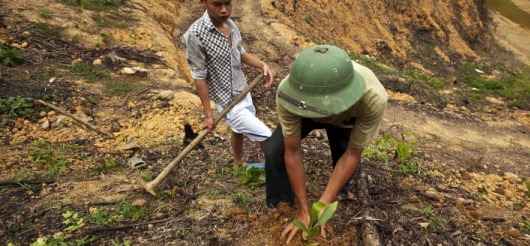The aim of forest and landscape restoration (FLR) is to develop diverse, productive and multifunctional landscapes that are resilient in the face of economic fluctuations and climatic change. FLR shifts the emphasis away from simply maximizing tree cover towards re-establishing multiple ecosystem functions in previously degraded landscapes, striving for a balance between restoring environmental services and improving the productive capacity of land for agriculture, forestry and other land uses.
FLR differs from site-level forest reforestation because it explicitly seeks to restore ecological processes such as hydrological and nutrient cycles, soil development, and wildlife population dynamics that operate or are only effective at a larger – or “landscape” – scale. This is the reason that the term “restoration” is used in preference to “reforestation”.
FLR is more than a technical approach; intrinsic to it is the involvement of landholders and other stakeholders in participatory decision-making processes. It makes use of collaborative approaches to harmonize the many land-use decisions of landholders with the aims of improving both ecological integrity and economic outcomes and enhancing the socioeconomic development of local communities.
Because the knowledge and expertise of individuals is a key resource for landscape restoration, it is particularly important that women and men can equally make a contribution. If landscape planning is to be effective, it must incorporate women’s as well as men’s concerns. Yet a real knowledge gap remains, as women are often excluded from participatory processes.
Landscape approaches involve landholders, political leaders and other stakeholders but very few of them are female. This means women are not able to participate in decisive discussions; yet, evidence shows that successful landscape approaches rely on the active participation of communities, the private sector, and other actors, including women.
Decisions on how FLR is implemented necessarily depend on the extent and nature of land degradation and the resources available, as well as the biophysical characteristics of the landscape mosaic. They also depend on the aspirations and needs of stakeholders and a range of social, economic and environmental factors.
- People undertaking FLR should consider four key questions:
- How much restoration is needed in a particular landscape?
- What type of restoration should be done at each location?
- Where in the landscape should those interventions be carried out?
- How should such a restoration programme be organized, funded and managed?
The amount of restoration
The amount of restoration
required in a landscape depends on the extent and condition of degraded former forestlands, agroecosystems and natural forests. FLR is not about maximizing tree cover but about meeting demand for forest goods and environmental services; it explicitly seeks to avoid further land degradation and the loss of natural forest, and any restoration should be balanced with other land uses, such as agriculture. A question that should be posed is, “Can a forest be restored in such a way as to complement agriculture, and even help increase food production, rather than competing for land?”
The optimal type of restoration
The optimal type of restoration
is likely to vary across a landscape, with different approaches used in different locations. In some places, trees might be planted in commercially oriented plantation monocultures, while efforts elsewhere might focus on restoring the original forest ecosystems (an approach referred to here as ecological restoration); crucially, the combination of restoration activities across a landscape should increase productivity and the provision of environmental services while serving the needs of people living in the landscape. Other restoration efforts might involve the re-introduction of some (but not necessarily all) the forest tree species originally found in the landscape (often referred to as rehabilitation), or various forms of agroforestry. Figure 1 presents a typology of possible restoration interventions.
The location
The location
of an FLR intervention is influenced by considerations such as the location of the most degraded areas in the landscape and where in the landscape restoration is most needed or would be most efficient in removing impediments to ecological functioning. Examples of high-impact locations are steep, eroding slopes; riparian areas; corridors between natural forest remnants; and buffer areas around residual forest patches. The location of an intervention may also be influenced by social or demographic factors, economic factors such as access to markets (which will be a determinant of the profitability of products produced in the restored area), and local, subnational or national priorities.
The planning and organization
The planning and organization
of FLR is more complex than site-level forest restoration or rehabilitation. FLR has a political dimension because it often operates across political jurisdictions (e.g. local government boundaries) and because it has implications for the production of food and wood products as well as for the provision of environmental services such as clean water and carbon storage and the meeting of cultural and recreational needs. FLR interventions aimed at changing the nature and composition of a landscape mosaic is likely to benefit some landholders and disadvantage others. Stakeholders other than landholders, such as downstream water users who stand to benefit from improved water quality, may also have an interest in the outcomes of FLR interventions. The best way of ensuring that decisions on land-use management – including those related to FLR – are broadly acceptable to diverse stakeholders is to engage those stakeholders in the decision-making process. FLR proponents should reconcile subnational or national objectives (e.g. for watershed protection or biodiversity conservation) with the goals of local communities and individual landholders. A judicious mix of top-down and bottom-up planning and management is likely to be needed.





